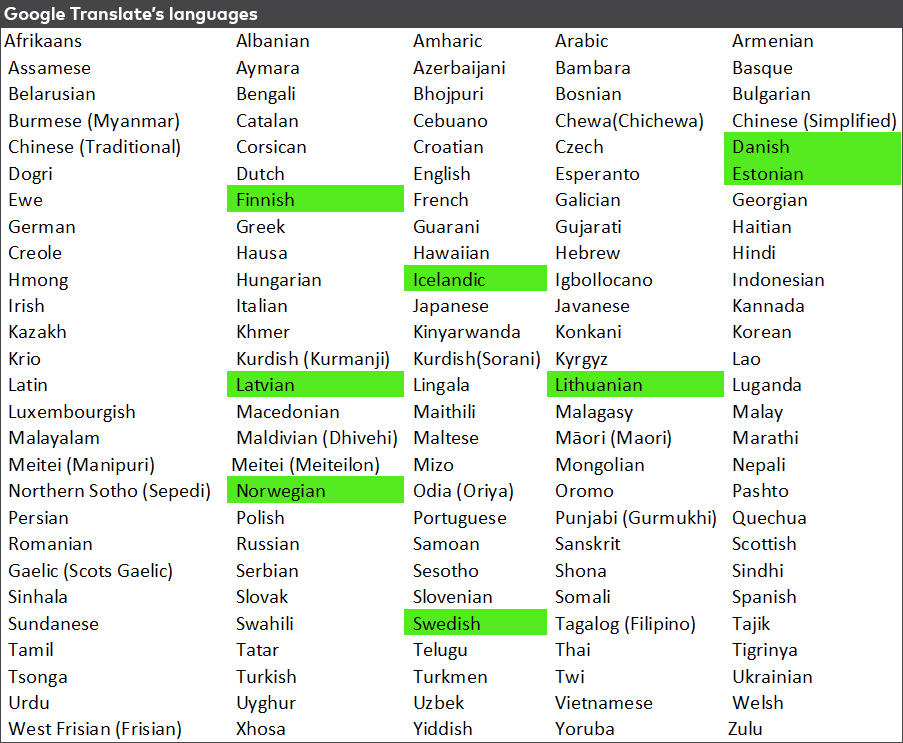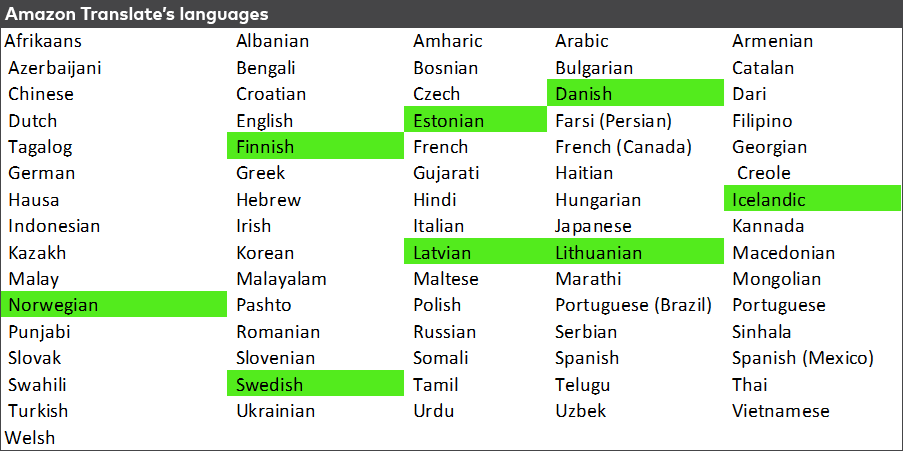Machine translation services
Overview
There are currently a large number of both publicly funded and commercial (cost-free and paid) machine translation services available. Cost-free commercial services usually collect the translated text for themselves and use them to improve the service. Google Translate, offered by Google, is an example of a cost-free commercial service that collects the translated data and uses it for improving future translations.
The service providers also differ based on the translation methods used and the field of work the translator service is aimed at (healthcare, education, consulting, law, etc.). Large tech companies, such as Microsoft, Amazon, and Google, have produced their own translation services, but also smaller independent companies have started to emerge. Growing popularity of the cloud-based application strengthens the market, while at the same time, customer-driven company operations drive the need for machine translation services.
It is important to recognise the nature and characteristics of the content that needs to be translated, and the aimed use cases for the translated texts – whether close-enough translation is acceptable or is there a need for human inspection and quality control of the translated text. Many machine translator engines can technically be integrated into core systems through API interface, but it should be thoroughly assessed as to whether that is needed and reasonable.
Benefits of commercial machine translator services:
- Ability to quickly translate text into several languages
- Ability to save and store the original text
- Ability to organise stored translations for future use
- Ability to translate words, sentences, paragraphs and entire documents
- Possibility of add-on features
- Commercial machine translators are currently mostly based on neural networks
Paid commercial translation services | Free commercial translation services |
Amazon Translate | Bing Microsoft Translator |
Crowd's | Google Translate |
MemoQ Translator PRO | DeepL |
Mesource | Reverso Translation |
Systran Translate PRO | Systran |
Smartling | |
TextUnited |
Picture 1. Paid and free commercial translation services.
In this overview, Google Translate and Amazon Translate were selected to be more closely viewed, together with the European Commission’s eTranslation service. Both Google Translate and Amazon Translate are based on neural networks, and their specific strength for this review was the scale of language pairs available, covering all Nordic and Baltic languages. The EC’s eTranslation is aimed at European public authorities and is free-of-charge.
Google Translate
Google Translate is a cost-free online service that is based on neural networks. Google Translate can be used to translate words, texts and documents.
The engine works by scanning its own database that contains everything on Google and what other users have added to the Google Translate engine. The text is then analysed to find the most frequently used version of the target text. Google Translate is part of the commercial company Google, which means that in using this service, the input text can be stored and used for Google’s business operations.
As an engine, it is flexible and versatile, because it can be used with speech, it recognises images, and it is fast and efficient to use via internet browser. It is an effective tool for translating short texts and words, but translating large documents is usually not as accurate. The input text cannot be managed by the user.
The use of Google Translate requires an internet connection and a computing device, such as a computer, tablet or mobile phone. The source systems can be integrated with Google Translate via API interface.
Google Translate accepts the following document formats for translating: .doc, .docx, .odf, .pdf, .ppt, .pptx, .ps, .rtf, .txt, .xls and .xlsx.

Picture 2. Google Translate's set of languages. Nordic and Baltic languages highlighted.
Amazon Translate
Amazon Translate is a paid machine translation service based on neural networks that uses deep learning models to translate texts.
Amazon Translate requires an AWS (Amazon Web Services) user account to use the service. AWS is a cloud services company, part of Amazon.com Inc. Creating an AWS user means a user is created in the AWS system, which allows the user to deploy and manage resources in AWS, including Amazon Translate. The data obtained from the machine translation is stored in the AWS cloud, which is protected by AWS, using the AWS Shared Responsibility Model.
For secure data storing, AWS recommends the following:
- Ensuring safe account management with multi-factor authentication (MFA)
- Use SSL/TLS to interact with the resources in AWS
- Ability to track activity in API and AWS with CloudTrail
- Security is high with AWS encryption possibilities, along with all default security controls of AWS and its services
- Possibility to use advanced managed security services, such as Amazon Macie, which assists in discovering and securing personal data that is stored in Amazon Simple Storage Service
The service includes "Amazon Comprehend Medical" U.S. Health Insurance Portability and Accountability Act (HIPAA)-compliant translation, for secure translation of medical domain texts – a service which is currently only available in English. AWS also contains a feature called “Active Custom Translation” (ACT), where the user can influence, in a certain way, what the machine translation output will be, giving users more control over translation output.
Using Amazon Translate requires the organisation to perform actions, such as creating users on AWS, understanding AWS and data security principles, implementing protocols and generally managing the AWS-based system. AWS offers its customers technical support and consultations related to using, maintaining, and managing AWS services. Amazon Translate can also be integrated with other IT systems via API interface.
Amazon Translate accepts the following document formats for translating: .docx, .xlsx and .pptx.

Picture 3. Amazon Translate's set of languages. Nordic and Baltic languages highlighted.
EU eTranslation
The European Commission has created the eTranslation service for European public administrations, small and medium-sized enterprises, and universities.
eTranslation can be used to translate sentences and documents. The input texts must be over 30 characters long for the engine to recognise the language. The engine translates and preserves the original text format in all except pdf files, where the document format changes to docx format. Users can select the domain of the source text (such as education, law or healthcare) to produce a translation that follows the possible linguistic peculiarities of the specified domain. Attached to this overview is an example of the EU Language Technology Resources
The use of eTranslation requires the creation of a user account, except if the user already has EU Login credentials (formerly ECAS).
eTranslate accepts the following document formats for translating: .txt, .doc, .docx, .odt, .ott, .rtf, .xls, .xlsx, .ods, .ots, .ppt, .pptx, .odp, .otp, .odg, . otg, .htm, .html, .xhtml, .h, .xml, .xlf, .xliff, .sdlxliff, .rdf, .tmx or .pdf.

Picture 4. EU eTranslation's set of languages. Nordic and Baltic languages highlighted.
Machine translation and GDPR
In machine translation, it is important to consider the requirements of the data protection legislation (GDPR) for sharing and managing the translated data.
One way to manage this challenge is to use a machine translator that does not share data with third parties, but instead stores the data with the users’ own data warehouses. When procuring a service from a commercial operator, it should be ensured that the operator does not forward information to third parties, which is why having the translator engine on one’s own servers is one possible option to be used. If any data is collected by any translator service, it is important to be aware of where the data is stored.
By ensuring a GDPR-compliant service provider, the user can inquire the following information:
- Non-disclosure/confidentiality agreement with contractors
- Translation management system’s security
- How, where and by who the translated texts are handled before, during, and after the actual translation operation
- Standards and accreditations of the service and the service provider